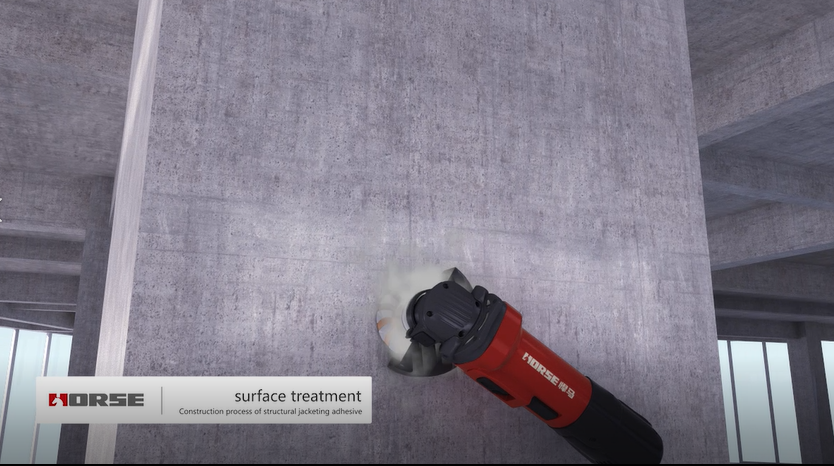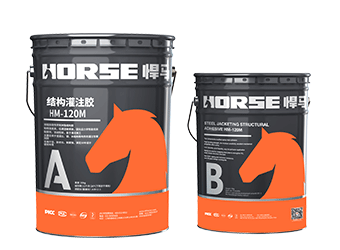Solutions
Horse Construction offers full range of structural strengthening materials with technical supports, documentation supports, products supports, project supports.
The Base Surface Treatment Of Bonding Steel Plate Method And Increasing Section Method Is Different

The quality of the interface treatment of the reinforcement project directly affects the results of the structural reinforcement design. If there are quality problems such as hollowing, falling off, and "double skin", it will affect the safety of structural transformation.
In the GB50550-2010 "Code for Construction Quality Acceptance of Building Structure Reinforcement Engineering", it is clearly stated that compared with the new construction, the building structure reinforcement project has increased the process of cleaning, repairing the original structure, components and interface treatment. What needs to be pointed out here is that these two processes are crucial to ensuring the quality and effectiveness of the reinforcement project, and construction personnel and supervisors must take them seriously. Supervisors should strictly supervise the entire process of these two processes, and should be responsible for negligence if a reinforcement quality accident is caused by oversight.
Below we discuss the interface treatment of the sticking steel plate method and the enlarged section method in the reinforcement technology, and sort out their differences in the interface treatment for your reference.
First of all, in the GB50550-2010 "Code for Acceptance of Construction Quality of Building Structure Reinforcement Engineering", 11.1.2 and 5.1.2 both require interface processing.
In the 9.1.2 (bonding steel method) and 5.1.2 (increasing section method) in GB50367-2013 "Code for Design of Reinforcement of Concrete Structures":
Difference 1:
There are no too many requirements for the base surface, but it is stipulated that the measured concrete strength grade on site shall not be lower than C15, and the surface positive tensile bonding strength shall not be lower than 1.5MPa. The GB50367-2013 "Code for Design of Reinforcement of Concrete Structures" stipulates that the on-site measured strength of concrete should not be lower than C13.
Looking at it again, in GB50550-2010 "Code for Acceptance of Construction Quality of Building Structure Reinforcement Engineering", the base surface treatment requirements of the sticking steel method should meet the requirements of Article 5.2.1, and should not be cut into trenches under any circumstances.
When we turn to Article 5.2.1 of GB50550-2010 "Code for Acceptance of Construction Quality of Building Structure Reinforcement Engineering", we find that it is the part of the enlarged section method. Is the base surface treatment of the sticking steel method and the enlarged section method the same? ? I'm sure to tell you that it's different.
Difference 2:
In the method of increasing section reinforcement, after the original component concrete interface (bonding surface) has been trimmed to reveal the new surface of the aggregate, it should be roughened with a hammer, grinder or high-pressure water jet; if necessary, grooves can also be chiseled . The sticking steel law stipulates that grooves should not be cut under any circumstances.
1. Flower hammering
It is advisable to use a 1.5kg~2.5kg sharp chisel hammer to pit pits on the concrete bonding surface to form a uniform distribution of dots with a depth of about 3mm and a number of 600 dots/m2 ~800 dots/m2. It can also be chiseled in a plum-shaped distribution with a depth of 4mm~5mm and a spacing of about 30mm.
2. Grinding machine or high-pressure water jet
It is advisable to use a coarse grinder with an output power of not less than 340W or a water jet with a pressure that meets the requirements of Appendix C of this code. The direction of the concrete bonding surface is perpendicular to the axis of the member, the grain depth is 3mm ~ 4mm, and the spacing is about 50mm.
3. Manual trenching
It is advisable to use a sharp and sharp chisel to cut transverse grooves perpendicular to the axis of the component on the solid concrete bonding surface with a groove depth of about 6mm and a spacing of 100mm ~ 150mm.
The GB50550-2010 "Code for Acceptance of Construction Quality of Building Structure Reinforcement Engineering" stipulates that when three or four sides are used to wrap beams and columns with newly poured concrete layers, the edges and corners of the cross section should be cut off at the same time as the roughening.
After finishing the above processing, use wire brush and other tools to remove loose aggregate, grit, scum and dust on the concrete surface of the original component, and rinse it with clean pressure water. If sprayed concrete is used for reinforcement, it is advisable to alternately flush with compressed air and water.
In Article 9.3.4 of GB50550-2010, it is stipulated that the edges and corners of the original member concrete section of the steel-bonded method should be rounded and polished, and the rounding radius should not be less than 20mm, and the rounded concrete surface should be free of loose aggregate and dust.

Difference 3:
The method of increasing the section only needs to remove the edges and corners of the section, while the method of sticking steel requires smooth grinding of the edges and corners of the section, and the radius should not be less than 20mm.
Through the interpretation of the specification, the treatment of the concrete base surface of the concrete structure with enlarged section method and steel-bonded reinforcement method should be in accordance with the relevant content of GB 50550-2010, and this item should also be referred to in the reinforcement design.
According to experience, the roughness of the base surface of the enlarged concrete cross-section is generally within 1cm, and the floating layer must be removed. For the concrete base surface of bonded steel or outer steel, the surface laitance layer should be roughened and be about 1~2mm thick.
During the construction process, it is necessary to prescribe the right medicine, strengthen management, and control the interface processing as a special process. From the first party to the design, supervision, and construction should be taken seriously. The base surface treatment standards corresponding to each reinforcement method should not be mixed, let alone neglect of duty and ignore the important process of base surface treatment.
You can find anything here you are in need of, have a trust trying on these products, you will find the big difference after that.

Two-component epoxy modified epoxy structural strengthening adhesive for bonded steel plate to concrete

Modified epoxy resin structural perfusion adhesive, specifically for supporting adhesive bonded steel reinforcement

High strength, unidirectional carbon fiber sheet pre-saturated to form a carbon fiber reinforced polymer (CFRP) sheet used to strengthen structural concrete elements.